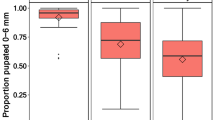Abstract
The spatial distribution, pupation behaviour and natural enemies of Cirina forda in the soil around its host, the sheanut tree, Vitellaria paradoxa were investigated in the field. Results indicated that final instars pupated within a 6–15 cm depth of soil located within a 90-cm radius around the host tree. Pupal density was significantly higher (P < 0.05) in soils on the north and west axes than on the south and east axes around the host tree. Pupai mortality was significantly higher within the top 5 cm and beyond a 16 cm depth of soil around the host tree. Four fungal pathogens, Trichoderma sp., Aspergillus nigers, A. flaws and Fusarium solani isolated from diseased larvae were implicated in the significantly high larval and pupal mortality that occurred within a 90-cm radius of the host tree trunk. Percentage field parasitism of the eggs by a parasitic wasp Entedon sp. (Hymenoptera: Eulophiidae) averaged 18%. Investigation on the potential of these microorganisms for biological control of C. forda is ongoing. An integration of effective biocontrol agent(s) with a slow release insecticide with a penetration depth of 15–20 cm could form part of an integrated management plan for the pest.
Résumé
La distribution spatiale, le comportement de nymphose et les ennemis naturels de Cirina forda ont été étudiés au champ dans le sol entourant sa plante hôte Vitellaria paradoxa. Les résultats indiquent que la chenille du dernier stade se nymphose à une profondeur comprise entre 6 et 15 cm dans un rayon de 90 cm autour du tronc. La densité des chrysalides est significativement plus élevée (P < 0.05) dans les quarts nord et ouest que dans les quarts sud et est autour de l’arbre. La mortalité nymphale est significativement plus élevée dans la partie superficielle du sol (< 5 cm) et au delà de 16 cm de profondeur. Quatre champignons pathogènes, Trichoderma sp., Aspergillus nigers, A. flavus et Fusarium solani, isolés de chenilles malades sont impliqués dans la mortalité larvaire et nymphale très élevée observée dans un rayon de 90 cm autour du tronc. Le pourcentage de parasitisme au champ des oeufs par Entedon sp. (Hymenoptera: Eulophiidae) est en moyenne de 18%. La possibilité d’utiliser ces organismes à des fins de lutte biologique contre C. forda est actuellement à l’étude. l’utilisation combinée d’agents de lutte biologique efficaces et de traitements insecticides avec une pénétration de 15–20 cm pourrait constituer un projet de lutte intégrée du ravageur.
Similar content being viewed by others
References
Abiw D. K. (1990) Useful Plants of Ghana: West African Uses of Wild and Cultivated Plants. Intermediate Technology Publications and the Royal Botanical Garden, Kew, London.
Ande A. T. and Fasoranti J. O. (1995) Determination of the number of instars in Cirina forda Westwood (Lepidoptera: Saturniidae). Bioscience Research Communication 7, 57–60.
Ande A. T. and Fasoranti J. O. (1996) Description of the life stages of Cirina forda Westwood (Lepidoptera: Saturniidae). Nigerian Journal of Entomology 13, 57–60.
Ande A. T. and Fasoranti J. O. (1997) Life history notes for the pallid emperor moth, Cirina forda Westwood (Lepidoptera: Saturniidae). journal of Lepidopterists Society 51, 269–271.
Bonkoungou E. G., Alexandre D. Y., Ayuk E. T., Depormmier D., Morant P. and Ouadaba J. M. (1994) Agroforestry Parklands of the West African semi-arid lands. Conclusions and recommendations of an International symposium. Ouagadougou. 25–27 October 1993. ICRAF/SALWA. 18 pp.
Bonkougou E. G. (1987) Monographie du Kante Butrospermum paradoxum (Gaertn, C.F.) Hepper, epecie agroforestriere a usages multiples. Institute de la Recherche en Biologie et Ecologie Tropicale, Ouagadougou, Burkina Faso.
Boorman J. P. T. (1970) The emperor moths (Saturniidae) of Nigeria. Nigerian Fields 35, 99–122.
Boorman J. P. T. (1978) West African Butterflies and Moths. Longman Group Ltd., London 2nd ed. 79 pp.
Golding F. D. (1929) Preliminary notes on the pests of sheanut trees in Northern Nigeria. Bulletin Dept Agric. Nigeria 8, 101–103.
Gomez K. A. and Gomez A. A. (1984) Statistical Procedures for Agricultural Research 2nd Ed.John Wiley & Sons Inc., New York 680 pp.
Harlan J. R. (1992) Crops and Man. 2nd Ed. America Society of Agronomy/Crop Science of America, Madison W.I.
Lovett P. N. and Hag N. (1999) Diversity of the sheanut tree in Ghana. Genetic Resources and Crop Evolution (in press).
Neumann K., Kahlheber S. and Uebel D. (1998) Remains of woody plants from Saouga, a medieval West African village. Vegetation Hist. Archeobot. 7, 57–77.
Odebiyi J. A., Bada S. O., Awodoyin R. O., Oni P. I. and Omoloye A. A. (2002) Population structure of Vitellaria paradoxa Gaertn F. and Parkia biglobossa (Jacq.) Berth., in the parkland of Nigerian Humid Savanna. West African Journal of Ecology (in press).
Odebiyi J. A., Bada S. O., Omoloye A. A., Awodoyin R. O. and Oni P. I. (2003) Diversity of phytophagous vertebrate and insect pests and hemi-parasitic plants of Parkia biglobosa Keay and Vitellaria paradoxa (Gaertn. F) Hepper and strategies for their control in the parklands of Nigeria humid savanna. Agroforestry Systems (in press).
Omoloye A. A., Anikwe J. C. and Joda A. O. (2000) Quantitative study of food consumption, utilization efficiencies and damage by Epilachna punctipennis Mulsant on Vernonia amygdalina Del. Applied Natural Sciences Research 1, 35–42.
Omoloye A. A., Anikwe J. C. and Tobih F. O. (2002) Laboratory biology and field behaviour of Epilachna punctipennis Mulsant on Vernonia amygdalina. Nigerian J. Entomol. 19 (in press).
Oni P. I. and Hall J. B. (1999) The ecology of a key multipurpose tree species Parkia biglobosa (Jacq.) Benth: The current state of knowledge. Nigerian J. Ecol. 1, 59–77.
Popoola L. and Tee N. T. (2001) Potentials of Vitellaria paradoxa Gaertn. F. in agroforestry systems in Benue State, Nigeria. Nigerian J. Ecol. 3, 65–74.
Author information
Authors and Affiliations
Corresponding author
Rights and permissions
About this article
Cite this article
Odebiyi, J.A., Omoloye, A.A., Bada, S.O. et al. Spatial Distribution, Pupation Behaviour and Natural Enemies of Cirina Forda Westwood (Lepidoptera: Saturnhdae) Around Its Host, The Sheanut Tree, Vitellaria Paradoxa C. F. Gertn. Int J Trop Insect Sci 23, 267–272 (2003). https://doi.org/10.1017/S1742758400023663
Accepted:
Published:
Issue Date:
DOI: https://doi.org/10.1017/S1742758400023663




